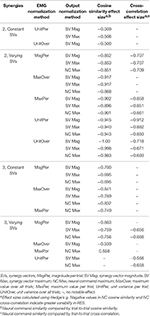


They can be used to decode motion intention for recognizing grasping movements or predicting gait events, and, especially, to understand the neurophysiological mechanisms of motor control. Many studies showed that surface electromyography (EMG) signals contain rich information that could be exploited in many fields. Inter-subject variability refers instead to the variation of motor patterns when multiple subjects repeat the same motion. Variability can be seen at many levels: intra-subject refers to the difference found in the same subject in multiple repetitions of the same task. Quantifying movement variability with detailed assessments is a crucial aspect for clinical and laboratory investigations in several contexts. The study deepens the available knowledge on muscle synergy-based motor function assessment and rehabilitation applications, discussing their applicability to real scenarios. The results show that muscle synergies are a valuable tool for quantifying variability at the muscle level and reveal that intra-subject variability is lower than inter-subject variability in synergy modules and related temporal coefficients, and both intra-subject and inter-subject similarity are higher than random synergy matching, confirming shared underlying control structures. In this study, we assess, in detail, intra-subject and inter-subject variability in a scenario based on a comprehensive dataset, including multiple repetitions of multi-directional reaching movements. Muscle synergies are a valuable method that can be used to assess such variability. However, very few studies have assessed, in detail, the intra-subject variability across movements and the inter-subject variability. Quantifying movement variability is a crucial aspect for clinical and laboratory investigations in several contexts.


 0 kommentar(er)
0 kommentar(er)
